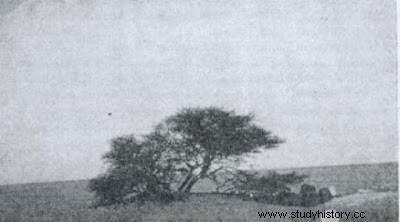 What the tree looked like in 1939. The trick:roots reaching 35 meters inland in search of water from a small aquifer that was discovered with the drilling of a well in 1939 .That phenomenon, of course, caught the attention of travelers who were lucky enough to come across it. There are testimonies from 1921 that spoke of him, and some experts even estimated his age in 300 years . Come on, an authentic natural relic . The fact that it survived human abuse for so many years was precisely because the Tuareg knew how to value its uniqueness. In fact, before arriving, a road sign indicated. But all that was going to change. In 1959 , a traveler who had described the tree in 1934, came across it again and wrote that he had found it almost dry , very affected. According to some testimonies, apparently a military truck had hit him, breaking a branch . That was incredible:a truck that had plenty of room to avoid the most isolated tree in the world had hit it... It seemed unbelievable, but that's how many reported it. Little more than a decade later, a second driver would clear the doubts of the skeptics.
What the tree looked like in 1939. The trick:roots reaching 35 meters inland in search of water from a small aquifer that was discovered with the drilling of a well in 1939 .That phenomenon, of course, caught the attention of travelers who were lucky enough to come across it. There are testimonies from 1921 that spoke of him, and some experts even estimated his age in 300 years . Come on, an authentic natural relic . The fact that it survived human abuse for so many years was precisely because the Tuareg knew how to value its uniqueness. In fact, before arriving, a road sign indicated. But all that was going to change. In 1959 , a traveler who had described the tree in 1934, came across it again and wrote that he had found it almost dry , very affected. According to some testimonies, apparently a military truck had hit him, breaking a branch . That was incredible:a truck that had plenty of room to avoid the most isolated tree in the world had hit it... It seemed unbelievable, but that's how many reported it. Little more than a decade later, a second driver would clear the doubts of the skeptics. The tree in 1961. Beside it the two wells that were dug.
The tree in 1961. Beside it the two wells that were dug.Despite the first blow , the tree was still alive, until in the fall of 1973 a drunk truck driver crashed into the solitary plant . This time he did not break a branch, but it was a head-on collision that ended the life of the acacia. 400 kilometers around, we remember, there was no other tree. 400 kilometers separate Madrid from Bilbao, Murcia or Granada. It is the distance between Seville and Almería, between Teruel and Vitoria, Cuenca and Zamora, Zaragoza and Albacete. 400 kilometers around and not a single tree, but desert and more desert. Come on, what space was there to pass. And that drunk truck driver came to collide with that one tree that in centuries no Tuareg or traveler had even dared to touch. His truck went off the road and came to a stop against that singularity.
 Moment when the remains of the tree were removed in 1973. The tree died, on November 8, 1973, removed from the site and his remains were transferred to the capital of Niger, Niamey, where they are still kept in a museum .In the place where that acacia rose defiantly, not a sad sprout is sighted, and in its place stands a commemorative monument made from metal pipes, gasoline drums and some other vehicle part (who knows if the lousy truck).
Moment when the remains of the tree were removed in 1973. The tree died, on November 8, 1973, removed from the site and his remains were transferred to the capital of Niger, Niamey, where they are still kept in a museum .In the place where that acacia rose defiantly, not a sad sprout is sighted, and in its place stands a commemorative monument made from metal pipes, gasoline drums and some other vehicle part (who knows if the lousy truck). Metal monument in the place where the most isolated tree in the world was raised.
Metal monument in the place where the most isolated tree in the world was raised.Today today, we don't know which tree will have picked up the baton of the Ténéré acacia as the most isolated tree in the world, and although some have proposed the Tree of Life of Bahrain, the truth is that its radius of 2 kilometers without a companion is far from that of Niger. But in order not to be left with this bad taste in our mouths, we leave you with a bit of music because a song by the Spanish rock group Los Nikis has a song called Paris-Dakar which goes like this:
I'm the fastest man in the country,
I'm number one from Paris.
In my horoscope He says I'm going to succeed,
and everyone thinks I can win the Paris-Dakar.
A mistake has ruined everything,
I crashed into the Ténéré tree .
The horoscope has failed again,
I think I won't be able to win the Paris-Dakar.
Two thousand five hundred natives
come screaming at me:
I cut down his sacred tree ,
I think I'm going to die.
He was the fastest man in the country,
he was number one since Paris.
Now they're going to cook me and eat me,
this is no way to end the Paris-Dakar,
this is no way to end the Paris-Dakar.
- The 153 Club:
- "L'Arbre du Ténéré, 1".
- "L'Arbre du Ténéré, 2".
